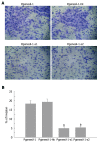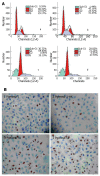Silencing SMYD3 in hepatoma demethylates RIZI promoter induces apoptosis and inhibits cell proliferation and migration
- PMID: 17963297
- PMCID: PMC4171257
- DOI: 10.3748/wjg.v13.i43.5718
Silencing SMYD3 in hepatoma demethylates RIZI promoter induces apoptosis and inhibits cell proliferation and migration
Abstract
Aim: To investigate the role of SMYD3 in hepatocellular carcinoma (HCC) development and progression and to verify whether its regulation activity was through RIZ1 inactivation.
Methods: Expression of SMYD3 in HCC cell lines and tissues were measured; silencing of SMYD3 by RNA interference (RNAi) was effectuated, hepatoma cell proliferation, migration and apoptosis were tested, with RIZ1 CpG promoter methylation, and corresponding mRNA expression were investigated.
Results: SMYD3 over-expression in HCC was associated with RIZ1 hypermethylation and mRNA down-expression. Suppression of SMYD3 expression de-methylated RIZ1 CpG promoter (P < 0.01) and increased RIZ1 mRNA expression (P < 0.01). Consequently, SMYD3 down-expression with RIZ1 de-methylation strongly inhibited hepatoma cell growth (MTT inhibitory rates: Pgenesil-1-s1 60.95% +/- 7.97%, Pgenesil-1-s2 72.14% +/- 9.68% vs Pgenesil-1-hk 6.89% +/- 4.12%, P < 0.01) and migration (Pgenesil-1-s1 4.24% +/- 1.58%, Pgenesil-1-s1 4.87% +/- 0.73% vs Pgenesil-1 19.03% +/- 4.63%, Pgenesil-1-hk 19.95% +/- 5.21%, P < 0.01) and induced apoptosis (FCM subG1 phase Pgenesil-1-s1 19.07% +/- 1.78%, Pgenesil-1-s2 17.68% +/- 2.36% vs Pgenesil-1 0.47% +/- 0.12%, Pgenesil-1-hk 1.46% +/- 0.28%, P < 0.01. TUNEL-positive cells: Pgenesil-1-s1 40.24% +/- 5.18%, Pgenesil-1-s2 38.48% +/- 4.65% vs Pgenesil-1 2.18% +/- 1.34%, Pgenesil-1-hk 2.84% +/- 1.22%, P < 0.01) in HepG2 cells.
Conclusion: These results demonstrate that SMYD3 plays a critical role in the carcinogenesis and progression of HCC. The proliferation, migration induction and apoptosis inhibition activities of SMYD3 may be mediated through RIZ1 CpG promoter hypermethylation.
Figures






Similar articles
-
[Advances of histone methyltransferase SMYD3 in tumors].Zhongguo Fei Ai Za Zhi. 2014 Sep 20;17(9):689-94. doi: 10.3779/j.issn.1009-3419.2014.09.09. Zhongguo Fei Ai Za Zhi. 2014. PMID: 25248712 Free PMC article. Review. Chinese. No abstract available.
-
[Inhibition of SMYD3 gene expression by RNA interference induces apoptosis in human hepatocellular carcinoma cell line HepG2].Ai Zheng. 2006 May;25(5):526-32. Ai Zheng. 2006. PMID: 16687068 Chinese.
-
[Suppression of SMYD3 expression in HepG2 cell by shRNA interference].Zhonghua Gan Zang Bing Za Zhi. 2006 Feb;14(2):105-8. Zhonghua Gan Zang Bing Za Zhi. 2006. PMID: 16494778 Chinese.
-
Effect of the downregulation of SMYD3 expression by RNAi on RIZ1 expression and proliferation of esophageal squamous cell carcinoma.Oncol Rep. 2014 Sep;32(3):1064-70. doi: 10.3892/or.2014.3307. Epub 2014 Jul 3. Oncol Rep. 2014. PMID: 24993551
-
HBx represses RIZ1 expression by DNA methyltransferase 1 involvement in decreased miR-152 in hepatocellular carcinoma.Oncol Rep. 2017 May;37(5):2811-2818. doi: 10.3892/or.2017.5518. Epub 2017 Mar 21. Oncol Rep. 2017. PMID: 28339081
Cited by
-
SMYD3 contributes to a more aggressive phenotype of prostate cancer and targets Cyclin D2 through H4K20me3.Oncotarget. 2015 May 30;6(15):13644-57. doi: 10.18632/oncotarget.3767. Oncotarget. 2015. PMID: 25980436 Free PMC article.
-
SMYD3: An Oncogenic Driver Targeting Epigenetic Regulation and Signaling Pathways.Cancers (Basel). 2020 Jan 6;12(1):142. doi: 10.3390/cancers12010142. Cancers (Basel). 2020. PMID: 31935919 Free PMC article. Review.
-
Effect of SMYD3 on biological behavior and H3K4 methylation in bladder cancer.Cancer Manag Res. 2019 Sep 2;11:8125-8133. doi: 10.2147/CMAR.S213885. eCollection 2019. Cancer Manag Res. 2019. Retraction in: Cancer Manag Res. 2023 Jul 07;15:625-626. doi: 10.2147/CMAR.S429272. PMID: 31564972 Free PMC article. Retracted.
-
Playing on the Dark Side: SMYD3 Acts as a Cancer Genome Keeper in Gastrointestinal Malignancies.Cancers (Basel). 2021 Sep 2;13(17):4427. doi: 10.3390/cancers13174427. Cancers (Basel). 2021. PMID: 34503239 Free PMC article. Review.
-
[Advances of histone methyltransferase SMYD3 in tumors].Zhongguo Fei Ai Za Zhi. 2014 Sep 20;17(9):689-94. doi: 10.3779/j.issn.1009-3419.2014.09.09. Zhongguo Fei Ai Za Zhi. 2014. PMID: 25248712 Free PMC article. Review. Chinese. No abstract available.
References
-
- Egger G, Liang G, Aparicio A, Jones PA. Epigenetics in human disease and prospects for epigenetic therapy. Nature. 2004;429:457–463. - PubMed
-
- Lund AH, van Lohuizen M. Epigenetics and cancer. Genes Dev. 2004;18:2315–2335. - PubMed
-
- Alaminos M, Dávalos V, Ropero S, Setién F, Paz MF, Herranz M, Fraga MF, Mora J, Cheung NK, Gerald WL, et al. EMP3, a myelin-related gene located in the critical 19q13.3 region, is epigenetically silenced and exhibits features of a candidate tumor suppressor in glioma and neuroblastoma. Cancer Res. 2005;65:2565–2571. - PubMed
-
- Hamamoto R, Furukawa Y, Morita M, Iimura Y, Silva FP, Li M, Yagyu R, Nakamura Y. SMYD3 encodes a histone methyltransferase involved in the proliferation of cancer cells. Nat Cell Biol. 2004;6:731–740. - PubMed
Publication types
MeSH terms
Substances
LinkOut - more resources
Full Text Sources
Other Literature Sources
Medical

